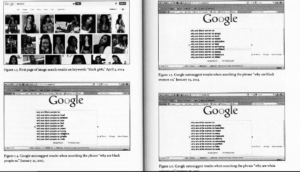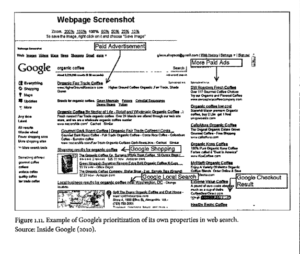Sameer’s DR#8

She was caught by husband in memory chip!

Hypothetical happiness!

Tuesdays 5:00-6:15pm | North Academic Center Library 1/301Y jriceevans@ccny.cuny.edu | (646) 801-1462

She was caught by husband in memory chip!

Hypothetical happiness!
Black Mirror Season 3 Episode 1: Nosedive
The episode of Black Mirror “Nosedive” is set in a world where everyone is connected to their phones and they rate each other from one to five stars for every interaction they have, which can impact their socio-economic status.
The main character is a young woman named Lacie who is consumed by her ratings. She gets an opportunity to make her ratings skyrocket by being the popular childhood friend’s maid of honor for her wedding. Her obsession leads to several mishaps and causes rapid decrease in her ratings. In this world you need a high rating if you want to buy the nicest houses or the nicest cars which is almost like having good credit. Even something as human as accepting coffee from anyone who is below a 3 could bring down your own rating.
I really enjoyed watching this episode because it makes you take a step back and realize how obsessed our generation really is with technology, our phones and social media. This episode teaches you that we should not always care what people think about us or how they perceive us. We should let loose and scream a little sometimes. Which is exactly what Lacie does toward the end of this episode. Once Lacie arrives at the wedding she sneaks in and manages to say a speech, but she becomes extremely upset to the point everyone negatively rates her and security comes and arrests her. She is taken to prison; the rating system is removed from her eyes and they placed Lacie in a cell. She gets into an argument with a man in a separate cell who’s in the same position as her, and both realize how liberating it is to speak your mind without worrying about being rated.

Emotional Speech and Reality

How they perceive us!
“The Offspring” From Star Trek
Artificial intelligence and artificial life have long been a controversial topic among scientists, psychologists, and many others who study human life and development. The main issue is differentiating artificial life from natural life, particularly in the case of human beings. Regarding artificial life, we often come to the dilemma of where artificial life ends, and where natural life begins. If something is sentient is it alive? Is a robot that can effectively communicate with a human being alive? Or are there other factors?
“The offspring” is the name of the star trek the next generation episode, in which Data, an android aboard the enterprise, creates an artificial being. Data created the offspring and programmed it with the ability to act almost human, much like Data. Data also considered the creation to be his child, and when confronted about it he claimed that he had as much right to “procreate” as the human members of the enterprise did.
Data creates his offspring in the belief that if any the members of the crew had decided to have a child, they would likely have not been met with any opposition. When confronted about the creation of his “child” he claims that once he had been accepted as a sentient member of the crew, he had also gained the right to “procreate,” however since he cannot procreate in the fashion that humans can, he just created his own child in the fashion that he could.
Lal is interrogated by Haftel later in the episode. During this interrogation scene, she begins to showcase more of her ability to have emotions. She expresses a strong desire to stay on the enterprise with Data, whom she calls her father, and the rest of the crew whom she is friends with. Although Haftel is too close minded to accept that a robot can display these kinds of emotions, it is very evident that Lal is capable of feelings. This is confirmed in the scene directly after when Lal visits Troi in his room after being interrogated. A clearly confused and distraught Lal is soon overwhelmed by the emotions that she is feeling and returns to Data’s lab. These few scenes in the episode play a role in showing how thin the line between real human emotions and “artificial” emotions can be. If this event were to happen, it would be difficult to argue that Lal would not be able to pass as a human being.
Although humans today have not been able to create a robot as sophisticated as Lal, it is only a matter of time before technology catches up to the imaginations of human beings. When it does, the philosophical line between artificial life and real life will become blurred. It will be impossible to break the scientific barrier as robots will probably never be made up of cells, but it will be difficult to look at a robot with these emotional capabilities and not at least regard it as a human being.

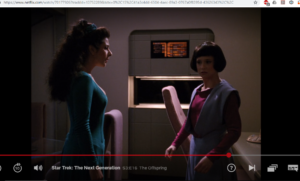
Very evident that Lal is capable of feelings!
Project 1 Reflection
I have done the technical report for Measurements which is my physics lab report. I would say I have done pretty good on this topic since measurements is our basic known ideas. Many of us already know how to do the simple measurements but this lab is concerned on fundamental units of length, mass and time. Also, I looked at the relationships between two quantities to see how they are dependent on each other and it will help us better understand our data which I even graphed in Excel. I have written clearly and more meaningful way for the procedure which is the strong part while doing the experiment.
In regards for doing this experiment in a different way, I have done four different methods for finding diameters and circumferences. So, I have figured the best way of getting the correct measurements for finding circular area is Google Map because it contains a computer program algorithm.
I could have mentioned the separate topic for the abstract and key words but those needed were mentioned on the introduction. I have inserted the graph so it would be easier to understand the relationship between the given facts.
The difficult part for me was to make a report question because I wasn’t sure about the types of questions. But I have mentioned its limitations, human errors while doing the experiment, correlation between the circumference of someone’s head and the time between heartbeats, and so on.
Overall, I would say I should be getting the points around 95+ out of 100 which is in the grade form of A. At last I believe this lab helped me to figure out if there’s any relationship between two components of an experiment and I hope anyone who wants to do this experiment would understand its procedure and find the correct way of measurement.

Ex Machina

Interaction!!


Ex Machina
The movie ‘Ex Machina’ directed by Alex Garland is very interesting with the logic and technological beliefs. The plot is about the Caleb smith going to Nathan home to test Ava intelligence who is a robot. First, I would like to say that this movie has so much going on regarding the relationship between people and technology. I believe that if I had watched this movie for entertainment purposes, that I wouldn’t have realized some of the meanings and underlying lessons that we should learn from watching this movie.
After a brief introduction between Caleb and Nathan, Nathan introduces Caleb to his experiment (Ava) and tells him that he wants him to spend the next week performing a live “Turing Test”. The Turing test was developed by Alan Turing in 1950. It is a test of a machine’s ability to exhibit behavior equivalent to that of a human (Wikipedia). Throughout the movie Caleb has sessions with Ava, who has the appearance of a robotic woman with the shape and size but has a human face. During these sessions he asks her questions to try and figure out her level of intelligence. But throughout the questioning, Ava begins to flirt with and manipulate Caleb, while also leading him to believe that she is human. Both Caleb and Ava gets closer and gets into romance which later on in the movie Nathan warns about the same to Caleb that Ava merely wants to escape the house so she is acting in such way and that this also proves that Ava despite being robot has the artificial intelligence capabilities and she has succeeded in human qualities and intelligence while Ava put the allegation on Nathan and says that Nathan is a cruel person and he treats Ava badly. What Caleb later finds out is that Nathan has been working on these humanoids for years and that he was chosen based on his web-search history at work. He was chosen because he was single, had no family, his searches for porn, and Nathan wanted to see if Ava could outsmart him. At the End Ava Leaves Caleb trapped in the house and leaves in the helicopter meant to take Caleb.
The ethical aspect of the movie is that the machines when given a autonomy or when they are let out of control of the human can go to any extent leaving behind the very human who have created it and the humanly robot can manipulate human beings. In totality it can be said the advanced humanly equipped with intelligence machines can never be friend in the long run to human race. The machine shall be let to assist the mankind and not overtake it. This must be ensured while developing such machines.

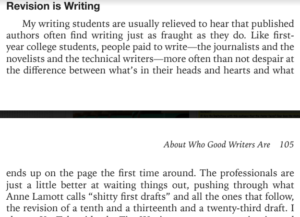
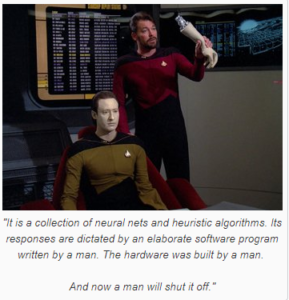
Hurtful Arguments
